Unveiling Modern Architecture: Iconic Designs, Timeless Styles, and Lasting Impact
Modern architecture has profoundly reshaped our urban landscapes and personal spaces. It ushered in an era of innovation, moving away from ornate historical styles to embrace clean lines, vast windows, and a focus on functionality. From towering skyscrapers that pierce the clouds to minimalist homes that blend with their environment, modern design is a cornerstone of our contemporary world.
This comprehensive guide invites you to explore the fascinating principles behind modern buildings and showcases an array of breathtaking examples from across the globe. We’ll delve into distinct modern architectural styles, ranging from sleek glass facades to raw concrete masterpieces, and even provide insights on how to integrate these groundbreaking ideas into your own home. By the end of this journey, you’ll gain a fresh perspective on the structures around you and perhaps spark new inspiration for your living or working environment.
Are you ready to discover architecture through a new lens?
What Makes Modern Architecture Truly Stand Out?
Modern architecture emerged as a revolutionary departure from historical traditions, embracing novel materials and a fresh philosophy on how buildings should serve human needs. This forward-thinking approach continues to influence contemporary design, masterfully balancing practical demands with captivating visual aesthetics.
The distinctive appeal of modern architecture stems from its honest use of materials like glass, steel, and concrete. Instead of concealing structural elements, modern buildings celebrate them, showcasing their inherent beauty and strength. This movement introduced the concept of open-plan living, minimizing interior walls to create expansive, fluid spaces. Natural light became a paramount design element, often maximized through large windows and transparent facades. The aesthetic is characterized by clean lines, geometric forms, and a deliberate absence of superfluous ornamentation, embodying the principle that “form follows function.”
These structures prioritize utility and efficiency. Common features include flat roofs, expansive windows, and simple, unadorned forms whose beauty derives from their effective performance and structural integrity, rather than elaborate decoration. This minimalist philosophy allowed for greater flexibility in interior layouts and a seamless connection between indoor and outdoor environments.
Today, the enduring influence of these modern ideas is evident everywhere. We see it in residential homes featuring open-concept living areas and large sliding glass doors that merge with outdoor patios. In commercial office buildings, flexible layouts and transparent facades foster collaborative environments and bring natural light deep into the workspace. Modern architecture fundamentally changed how we interact with our built environment, making it more functional, luminous, and connected.
Iconic Modern Architecture Examples Shaping Our World
Modern architecture represents a transformative approach to building design, prioritizing functionality, structural honesty, and streamlined forms. The following remarkable structures serve as testament to how architects have boldly pushed boundaries with innovative materials and construction techniques, creating spaces that elegantly respond to human needs and environmental contexts.
1. Fallingwater (USA)

Designed by Frank Lloyd Wright in 1939, Fallingwater in Mill Run, Pennsylvania, was conceived as a weekend retreat for the Kaufmann family. This architectural marvel is ingeniously situated directly above an active waterfall on Bear Run, with daring concrete terraces that cantilever outward from the main living areas. It stands as a prime example of organic architecture, where the building is not merely placed on the landscape but appears to grow directly from it.
The house integrates seamlessly with its natural environment through its strong horizontal lines, the use of locally quarried natural stone, and expansive windows that artfully draw the surrounding forest indoors. The constant, soothing sound of flowing water permeates every room, enhancing the immersive natural experience. Wright’s profound understanding of harmony between human habitation and the natural world is vividly demonstrated here, making Fallingwater an enduring symbol of architectural genius and environmental integration.
2. Sydney Opera House (Australia)
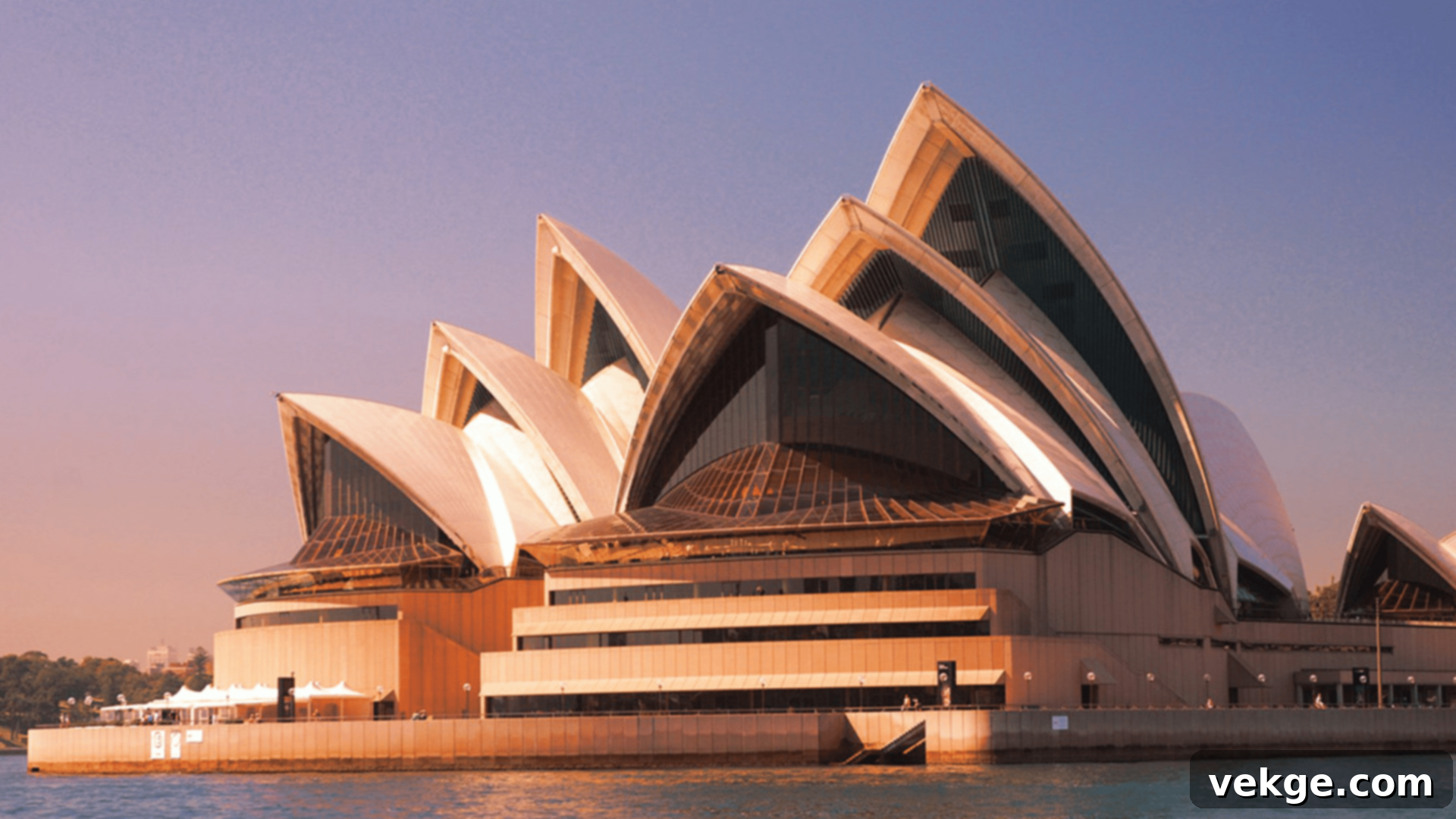
Jørn Utzon’s Sydney Opera House, completed in 1973, stands as one of the most globally recognizable buildings of the 20th century. After 14 years of challenging construction, this performing arts center became an instant icon on Sydney Harbour, distinguished by its spectacular white shell-shaped sails. Its innovative design propelled modern architecture to new artistic heights.
The complex houses multiple performance venues, with the largest accommodating up to 2,700 people. Utzon won an international competition with his groundbreaking design but famously departed the project before its completion due to creative and political disagreements. The structure masterfully combines advanced modern engineering with timeless, sculptural forms, utilizing intricate precast concrete shells covered with over one million glistening white and cream tiles. Its ambitious construction pushed the very limits of engineering capabilities of its era, solidifying its place as a symbol of architectural ambition and a cultural landmark.
3. Louvre Pyramid (France)
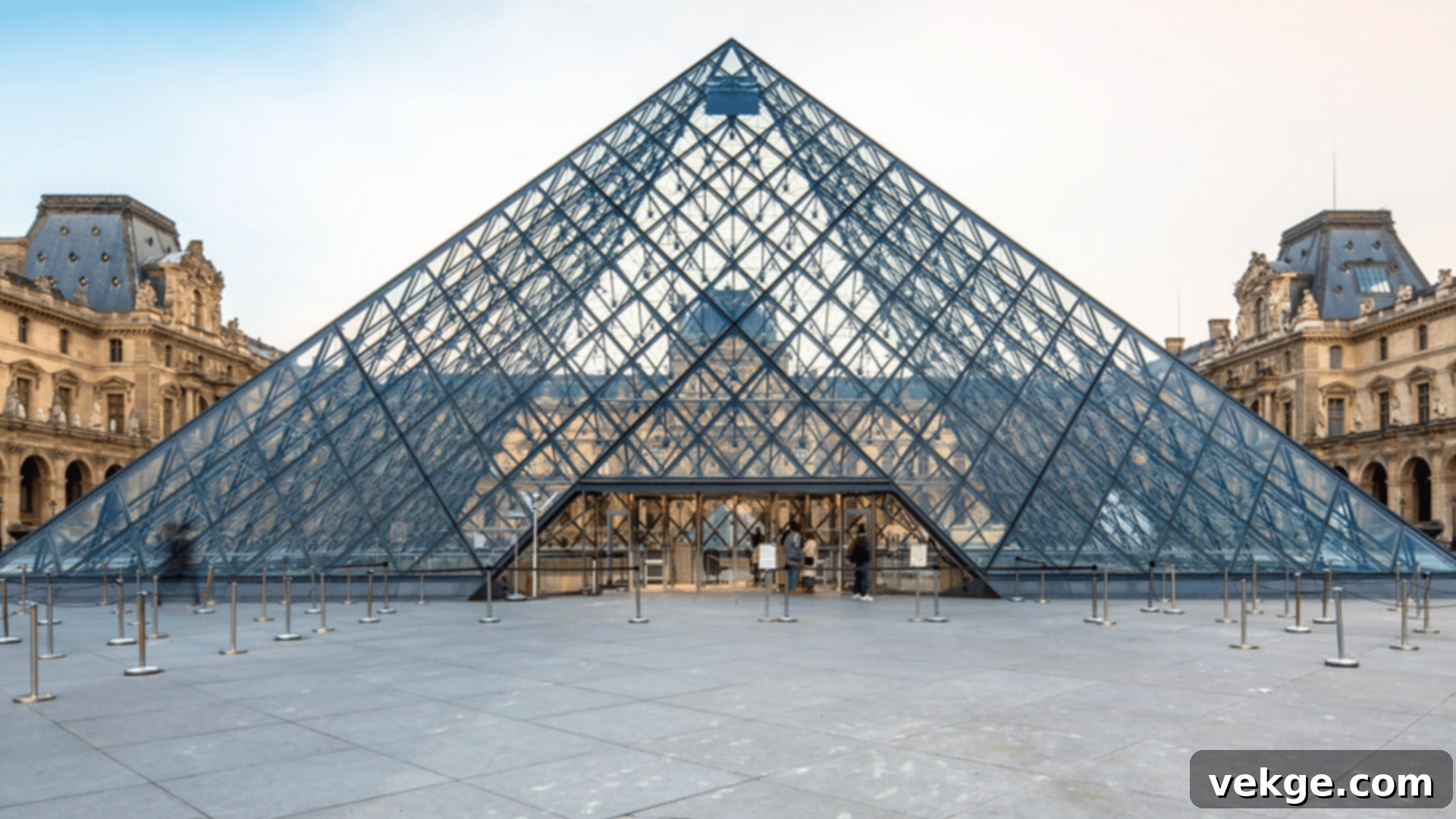
I.M. Pei’s striking glass and metal pyramid, completed in 1989, now serves as the principal entrance to the venerable Louvre Museum in Paris. This transparent structure stands in elegant contrast to the historic grandeur of the surrounding palace, representing a bold fusion of modern materials with classical architecture.
The pyramid rises 71 feet high from a square base, measuring 116 feet on each side, and is composed of 673 meticulously arranged glass panels. Initially a subject of considerable controversy among Parisians, it has since been embraced as an indispensable and iconic element of the city’s architectural landscape. The ingenious design allows abundant natural light to flood the vast underground reception area, minimizing visual impact on the ancient facades above. The Louvre Pyramid exemplifies a thoughtful blending of contemporary design with historical context, creating a new focal point that respectfully enhances its timeless surroundings.
4. The Guggenheim Museum (USA)
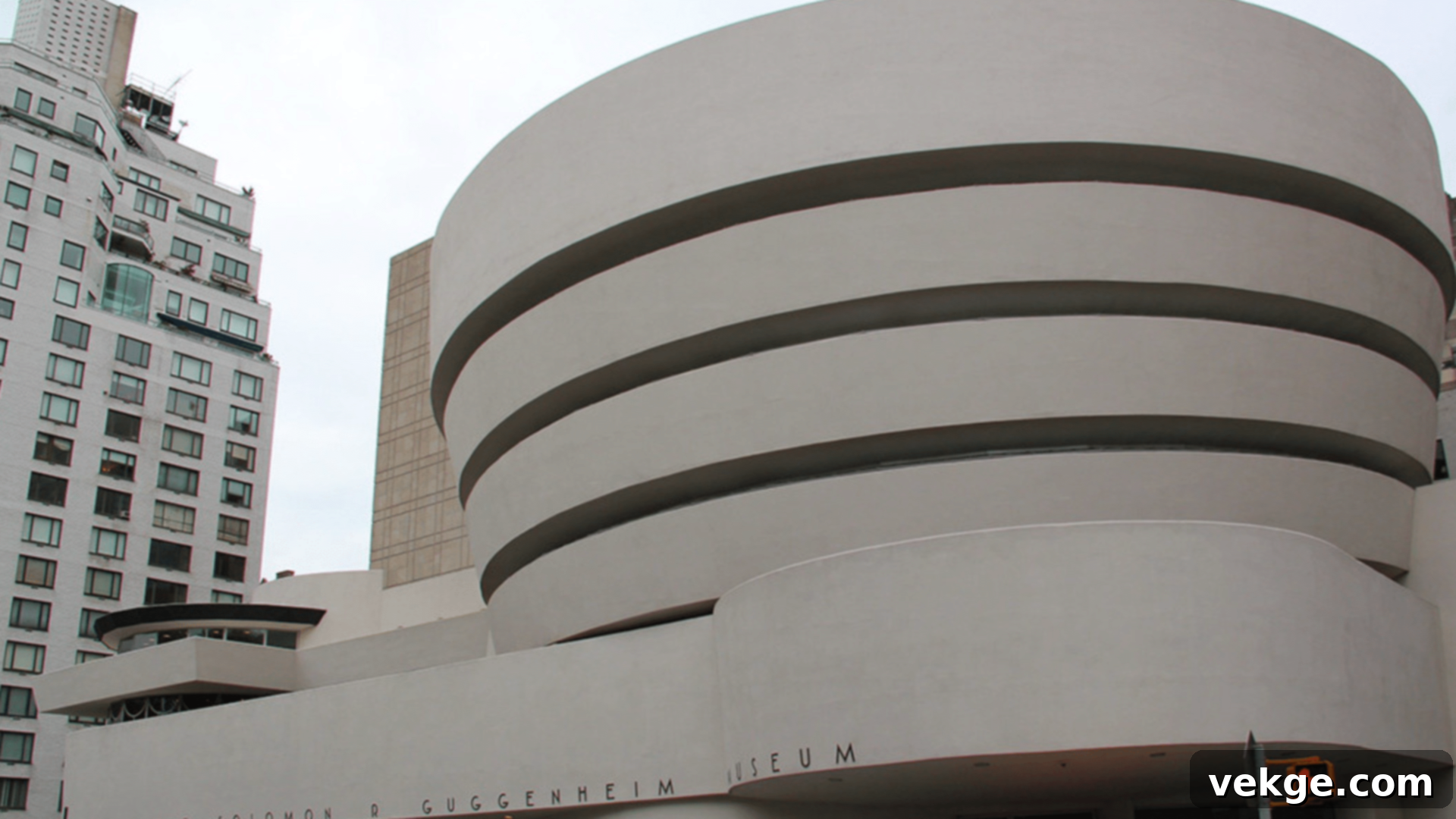
Frank Lloyd Wright’s Guggenheim Museum, which opened in New York City in 1959 after 16 years of meticulous planning and construction, is a monumental work of modern art itself. The building features a distinctive spiral ramp that gracefully coils upward around an open central void, allowing visitors to experience art while descending a continuous, gently sloping path. This revolutionary design creates a fluid and immersive experience, starkly contrasting with traditional museums composed of disconnected rooms.
The exterior presents a smooth, unadorned facade, a powerful organic form that dramatically contrasts with the angular buildings of Manhattan. Wright envisioned the building as a “temple of spirit,” a place where individuals could encounter art in a completely novel way. The Guggenheim fundamentally redefined the museum experience, emphasizing the interplay between art, visitor, and the architectural space itself.
5. Seagram Building (USA)
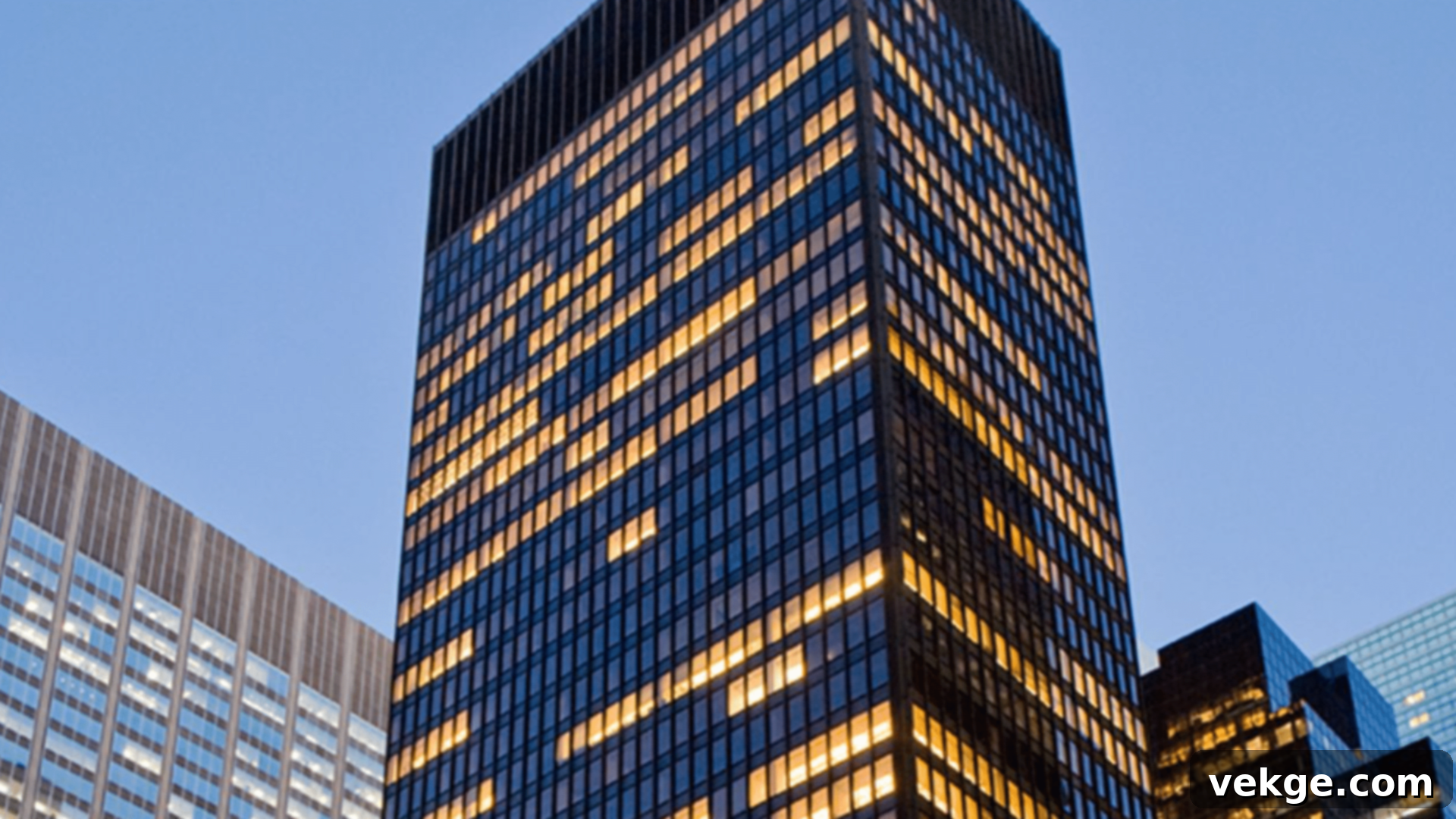
The Seagram Building, completed in New York City in 1958 by Ludwig Mies van der Rohe and Philip Johnson, is an archetypal example of the International Style. This 38-story office tower is renowned for its elegant glass and bronze exterior, which honestly expresses its underlying steel frame construction. The building’s meticulously detailed facade and exposed structural elements embody Mies’s famous dictum, “less is more.”
Setting a new precedent for urban planning, the building is set back from Park Avenue, creating a spacious public plaza that was revolutionary for commercial architecture at the time. Its minimalist design prioritizes perfect proportions, exquisite materials, and clean lines over any form of superficial decoration. The tower’s construction incurred an extraordinary cost of $41 million, partly because the client, Seagram’s spirits company, insisted on the finest materials available. The Seagram Building profoundly influenced countless office towers that followed, establishing a new global standard for corporate architecture.
6. Villa Savoye (France)
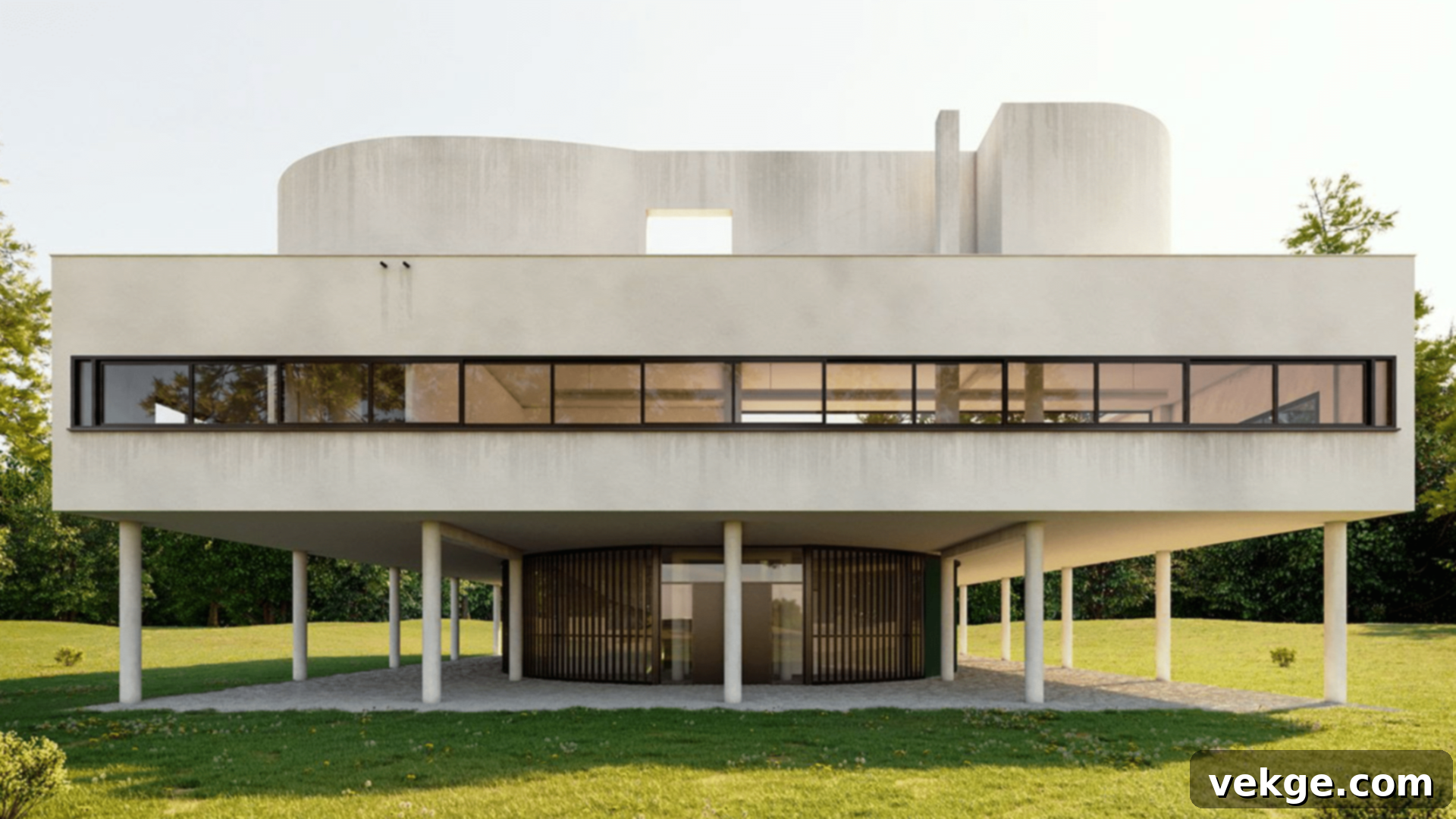
Le Corbusier’s Villa Savoye, completed in Poissy, France, in 1931, served as a pioneering weekend home for the Savoye family. This iconic white cubic structure is elevated above the ground on slender concrete columns, known as pilotis, which allowed a car to drive directly underneath – a crucial innovation in the burgeoning automobile age. The design fully encapsulates Le Corbusier’s “Five Points of Architecture,” featuring an open floor plan, a functional roof garden, horizontal ribbon windows, a free facade, and the defining pilotis.
A gentle ramp seamlessly connects all floors, creating a continuous and flowing spatial experience. Despite initial practical challenges, including persistent leaks, the Villa Savoye quickly became a powerful international symbol of modern domestic architecture. Nearly a century later, its revolutionary design continues to inspire and influence residential architecture worldwide, celebrated for its abstract beauty and radical redefinition of living space.
7. Eames House (USA)
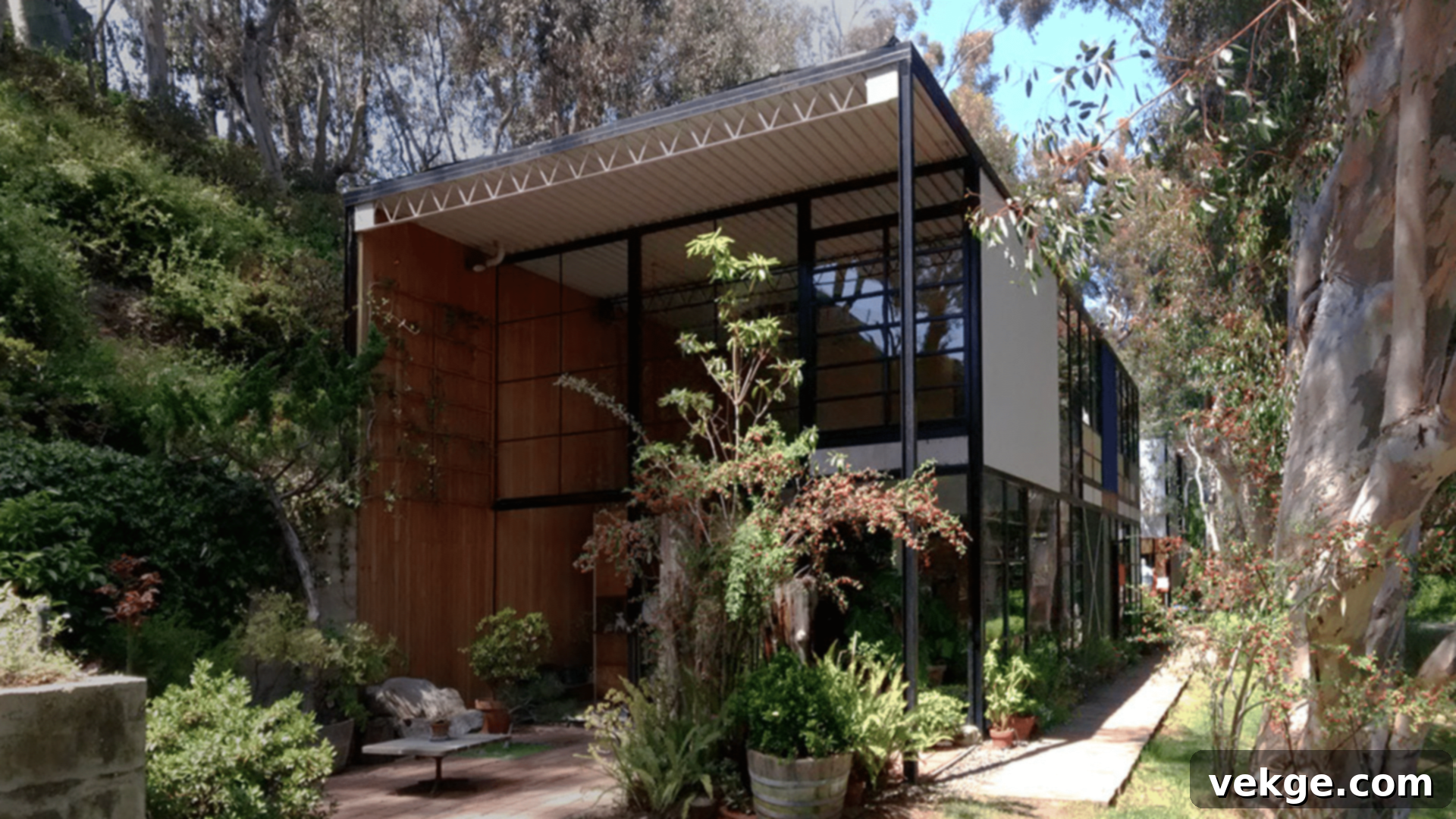
Charles and Ray Eames constructed their celebrated home and studio in Pacific Palisades, California, in 1949, as part of the influential Case Study House Program. This deceptively modest structure brilliantly utilizes standard industrial materials – prefabricated steel frames, glass, cement panels, and fiberglass – to create a light, airy, and adaptable living space that connects intimately with its serene eucalyptus grove setting. The colorful panels on the facade form a playful, Mondrian-like composition, adding a vibrant artistic dimension.
The interior features an open plan, thoughtfully filled with the couple’s diverse collections of folk art, books, and everyday objects, arranged with meticulous attention to detail. The Eames House powerfully embodies the democratic ideal that exceptional design could be achieved using common, affordable materials, making modern living accessible to average Americans during the post-war period. It remains a timeless testament to innovation, creativity, and the joy of living in a well-designed space.
8. Elbphilharmonie (Germany)
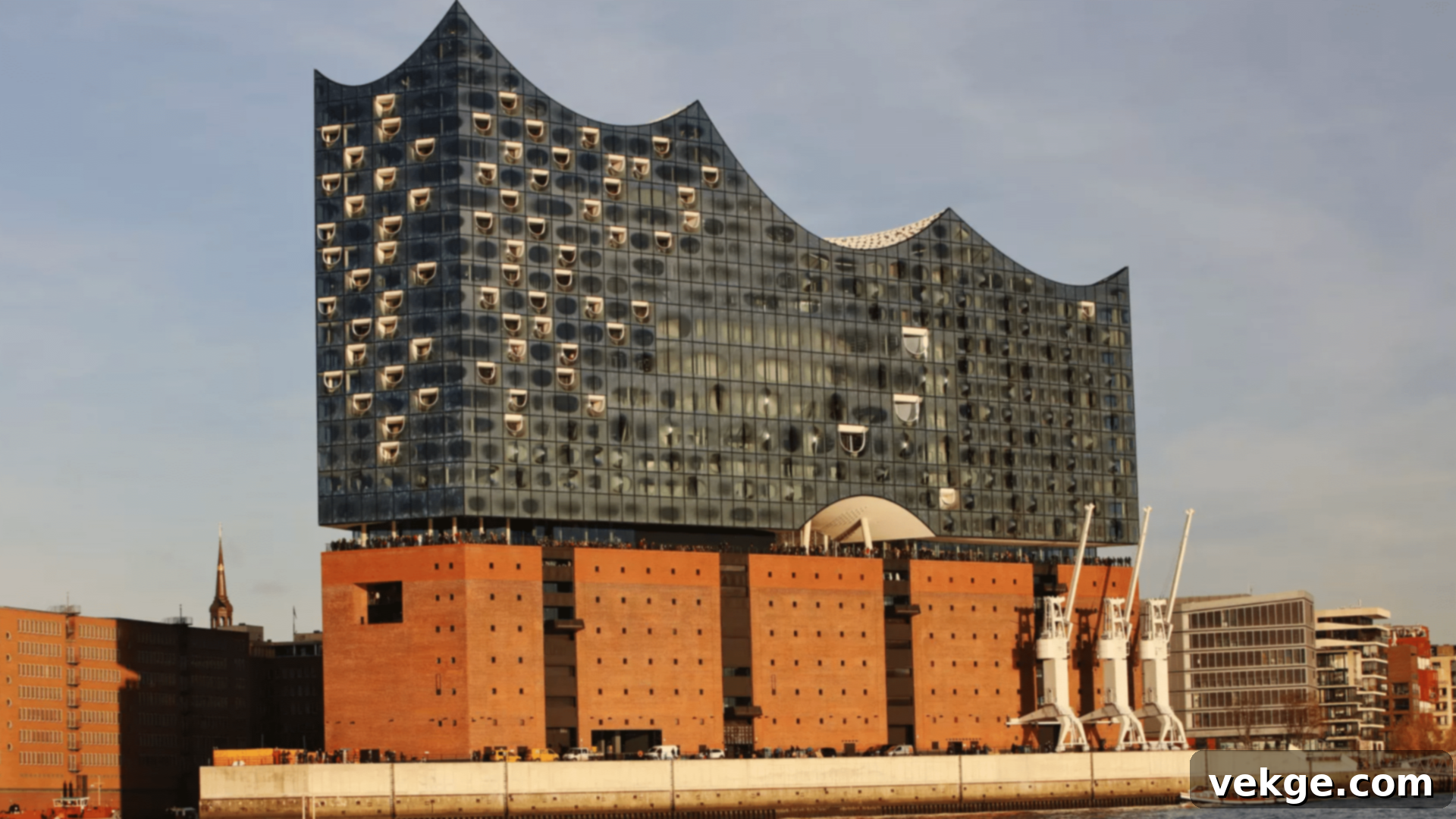
Herzog & de Meuron completed the magnificent Elbphilharmonie concert hall in Hamburg in 2016, following a lengthy and ambitious construction period. The building ingeniously transforms a former brick warehouse by adding a spectacular glass structure with a dynamic, wave-like roof atop its historic base. Its main concert hall is an engineering marvel, suspended on springs to completely isolate it from external noise, and features custom-designed acoustic panels that ensure optimal sound dispersion throughout the space.
A public plaza, strategically positioned between the old and new sections, offers breathtaking panoramic views of the harbor and the city. While the project faced initial criticism for cost overruns and delays, the Elbphilharmonie has since become an undeniable symbol of Hamburg’s cultural transformation and architectural ambition. The building elegantly bridges the city’s rich maritime past with its vibrant cultural future through this dramatic and innovative architectural statement.
9. Mies van der Rohe Pavilion (Spain)
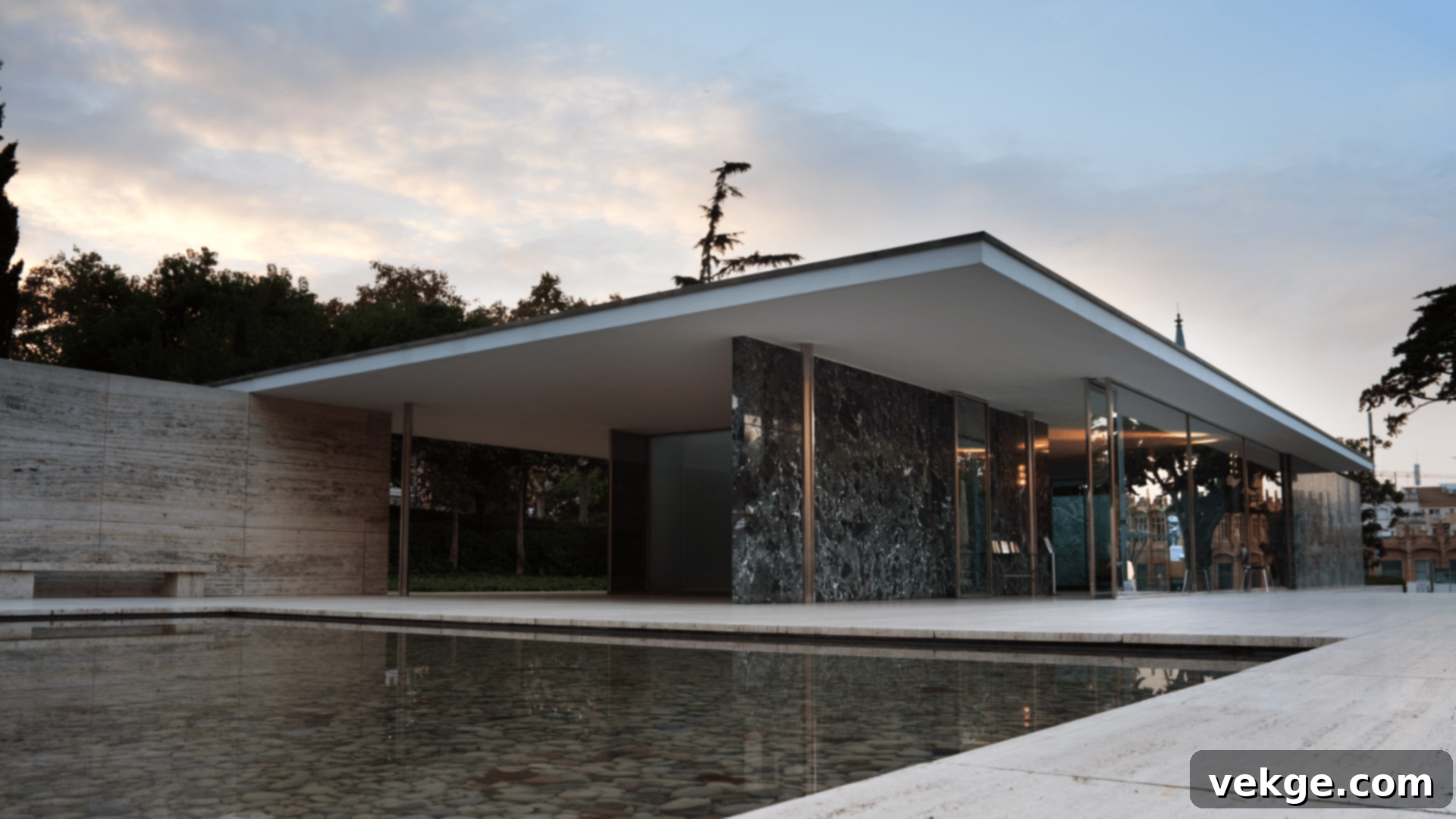
Ludwig Mies van der Rohe designed this temporary structure as the German national pavilion for the 1929 International Exposition in Barcelona. The building’s revolutionary simplicity features a minimal flat roof supported by slender, chrome-plated steel columns, with walls of polished glass, marble, and onyx that do not bear weight but rather define flowing, interconnected spaces. Water features, including two shallow reflecting pools, add to the serene atmosphere and beautifully mirror the architecture.
Though originally dismantled after the exposition, the pavilion was meticulously reconstructed in the 1980s due to its profound architectural significance and lasting influence. The minimalist space contains almost no decoration, save for a single sculpture and the famous Barcelona Chair, also designed by Mies. This eloquent composition perfectly embodies the essence of his celebrated phrase: “less is more,” making it a cornerstone of modern architectural thought.
10. The Shard (UK)
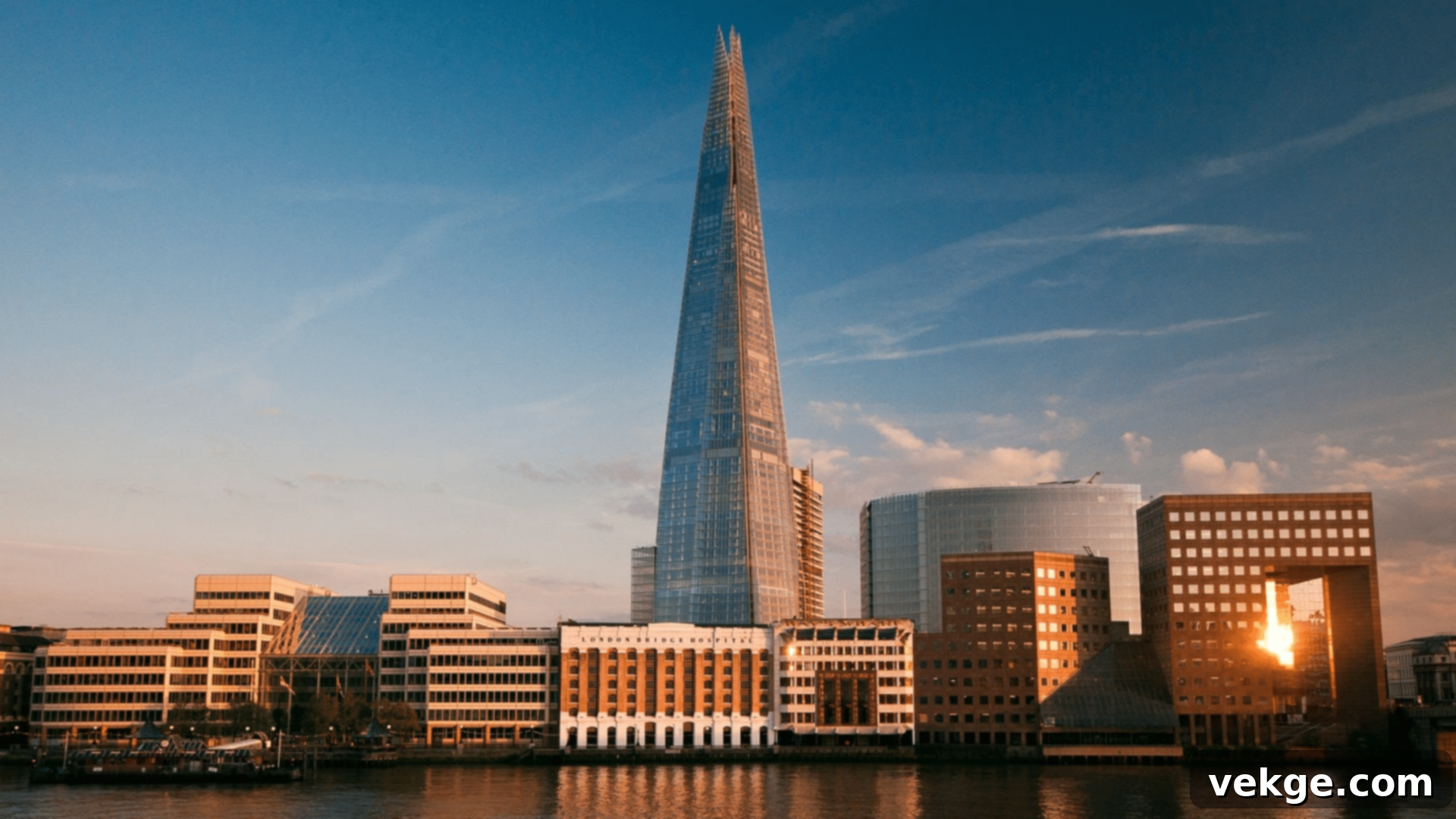
Renzo Piano’s breathtaking 1,016-foot glass tower in London, known as The Shard, opened in 2012 and briefly held the title of the tallest building in the European Union. The structure is characterized by eight sloping glass facades that dynamically reflect the ever-changing sky, often appearing to dissolve into the clouds on foggy days, perfectly fulfilling Piano’s vision of a “shard of glass.”
This mixed-use skyscraper thoughtfully integrates offices, high-end restaurants, a luxury hotel, residential apartments, and a popular public observation deck. Its construction employed advanced engineering techniques, including innovative top-down building methods where foundations were excavated simultaneously with the construction of upper floors. The Shard has dramatically transformed the London skyline, symbolizing the city’s growth as a global financial center while maintaining striking visual connections to historic landmarks like Tower Bridge.
11. Burj Khalifa (UAE)
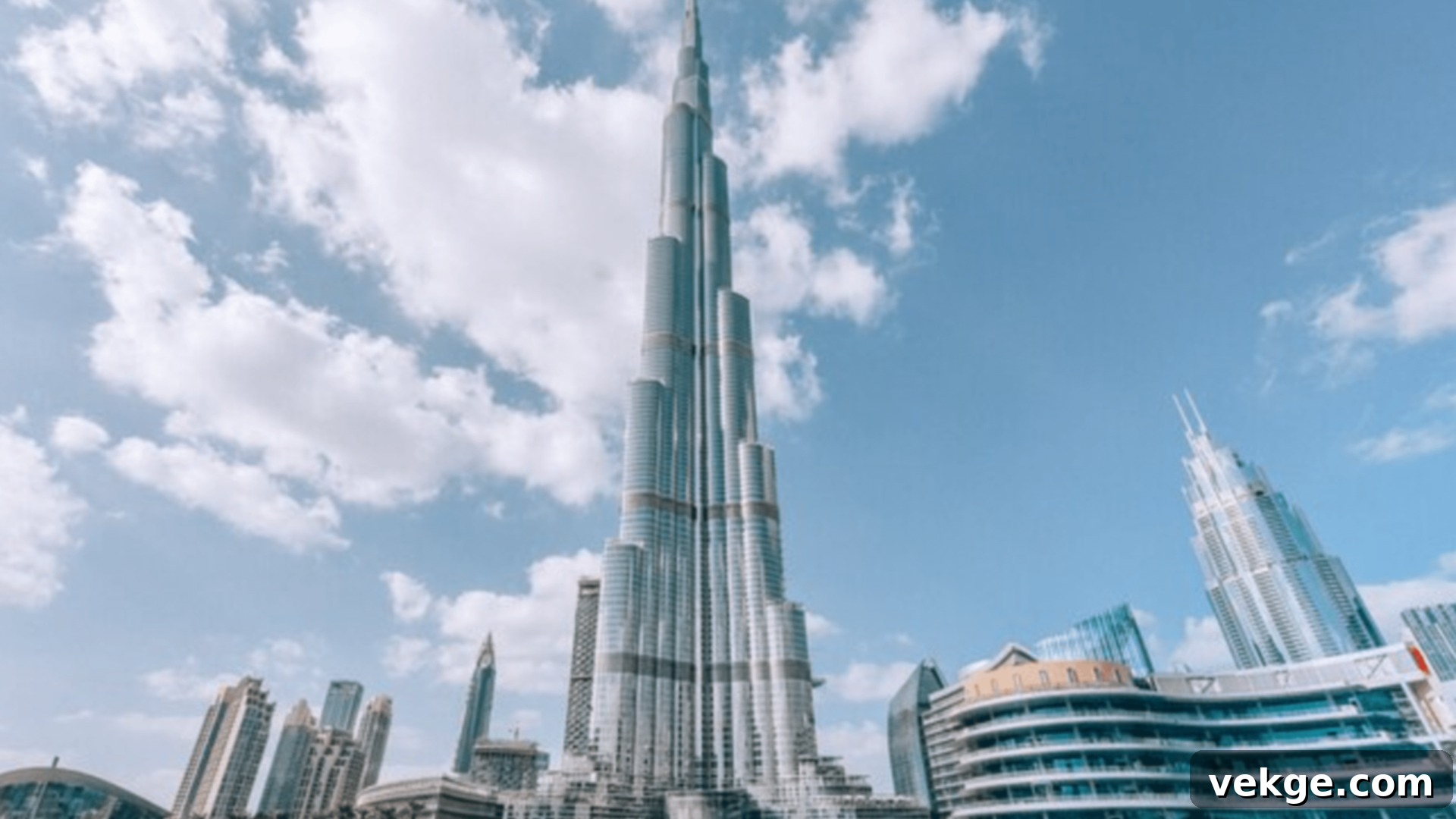
Adrian Smith designed the world’s tallest building, the Burj Khalifa, which majestically opened in Dubai in 2010, soaring to an astonishing height of 2,717 feet. The tower’s sophisticated design draws inspiration from regional Islamic architecture and the graceful desert flower Hymenocallis, featuring a distinctive Y-shaped floor plan that maximizes panoramic views while providing exceptional structural stability. This innovative form reduces wind resistance and optimizes the building’s footprint.
The exterior wall system utilizes high-performance reflective glazing, ingeniously engineered to reduce heat gain and manage solar glare, crucial for addressing the extreme challenges of the desert climate while preserving spectacular views. Construction required pioneering techniques, including high-strength concrete pumped to unprecedented heights. The Burj Khalifa is a vertical city, housing offices, luxurious residences, a hotel, multiple observation decks, and sophisticated mechanical floors that support its complex systems. This extraordinary structure stands as a monumental testament to human engineering achievement and Dubai’s remarkable transformation into a global business and tourism hub.
12. TWA Flight Center (USA)
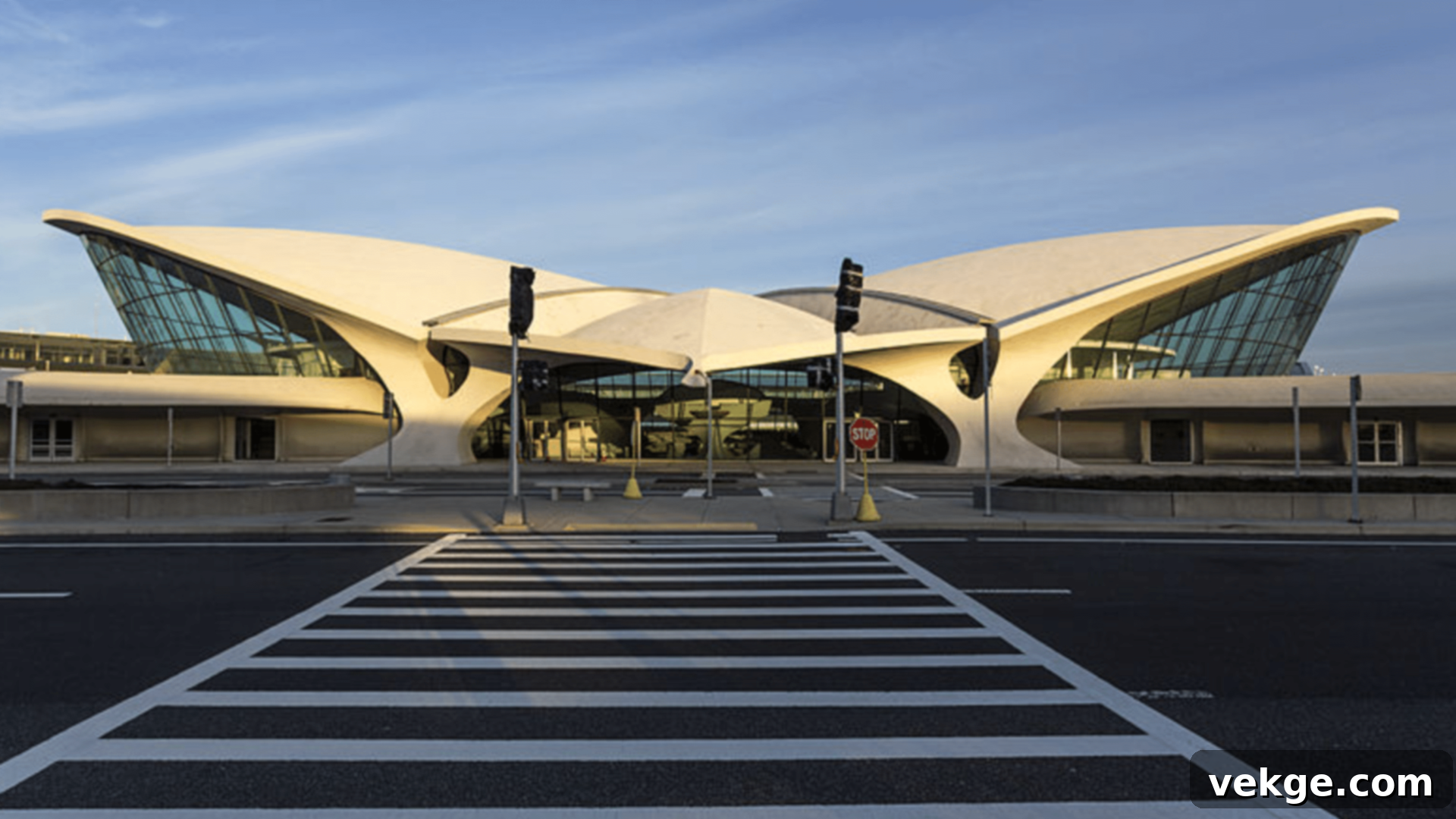
Eero Saarinen completed this iconic aviation terminal at New York’s JFK Airport in 1962, crafting a dramatic and highly expressive architectural ode to flight. The building features a breathtaking, sweeping concrete roof that appears to take wing, with a remarkable absence of right angles throughout its main structure. Expansive windows flood the interior with natural light, while vibrant red-carpeted lounges and curvilinear furniture reinforce the sense of dynamic motion and fluid elegance. Every detail was designed to evoke the excitement and romance of air travel.
After sitting vacant for years following TWA’s cessation of operations, the structure was meticulously restored and imaginatively converted into a hotel, preserving Saarinen’s visionary design while seamlessly integrating modern accommodations. The TWA Flight Center magnificently captures mid-century optimism about air travel and technological progress, embodying the exhilaration of the jet age through its distinctive, organic forms that brilliantly contrast with typical, utilitarian airport designs.
13. Bosjes Chapel (South Africa)
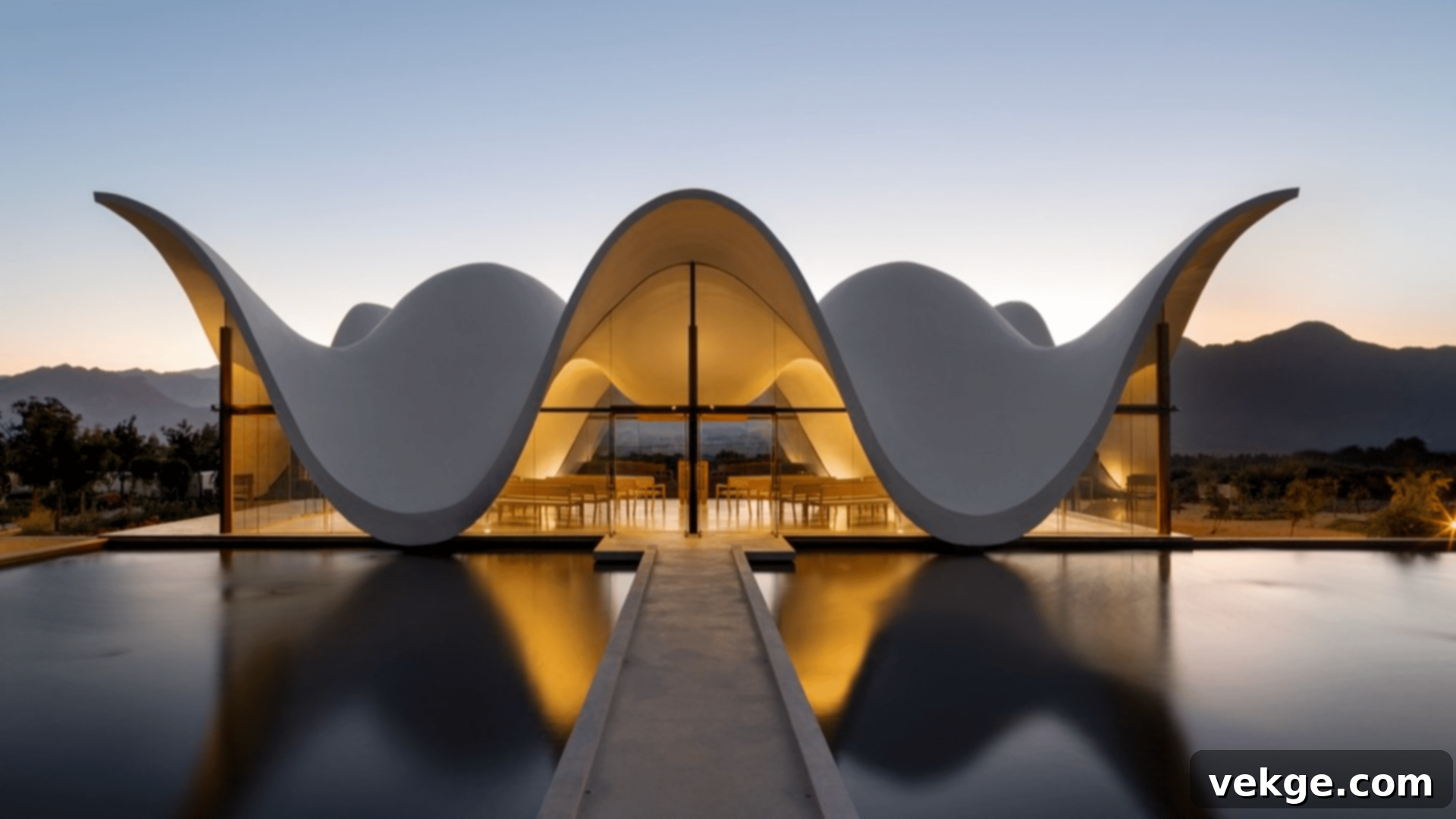
Steyn Studio completed this profoundly striking chapel in South Africa’s scenic Western Cape in 2016. The building’s most defining feature is its undulating white concrete roof, which gracefully appears to float above the landscape. Expansive glass walls provide breathtaking, uninterrupted views of the surrounding mountains and verdant vineyards, blurring the lines between the sacred interior and the natural world outside. The flowing, organic form subtly references the Biblical passage about God’s protection, likened to the shadow of wings.
The interior is elegantly simple, directing all attention to the dramatic views and a serene, cross-shaped reflecting pool. The chapel is nestled within a working farm and forms part of a larger complex that includes a restaurant and guest accommodations. This contemporary sacred space masterfully creates an atmosphere of profound tranquility through its graceful curves and sensitive integration with its majestic natural setting, offering a unique spiritual experience.
14. Neues Museum (Germany)
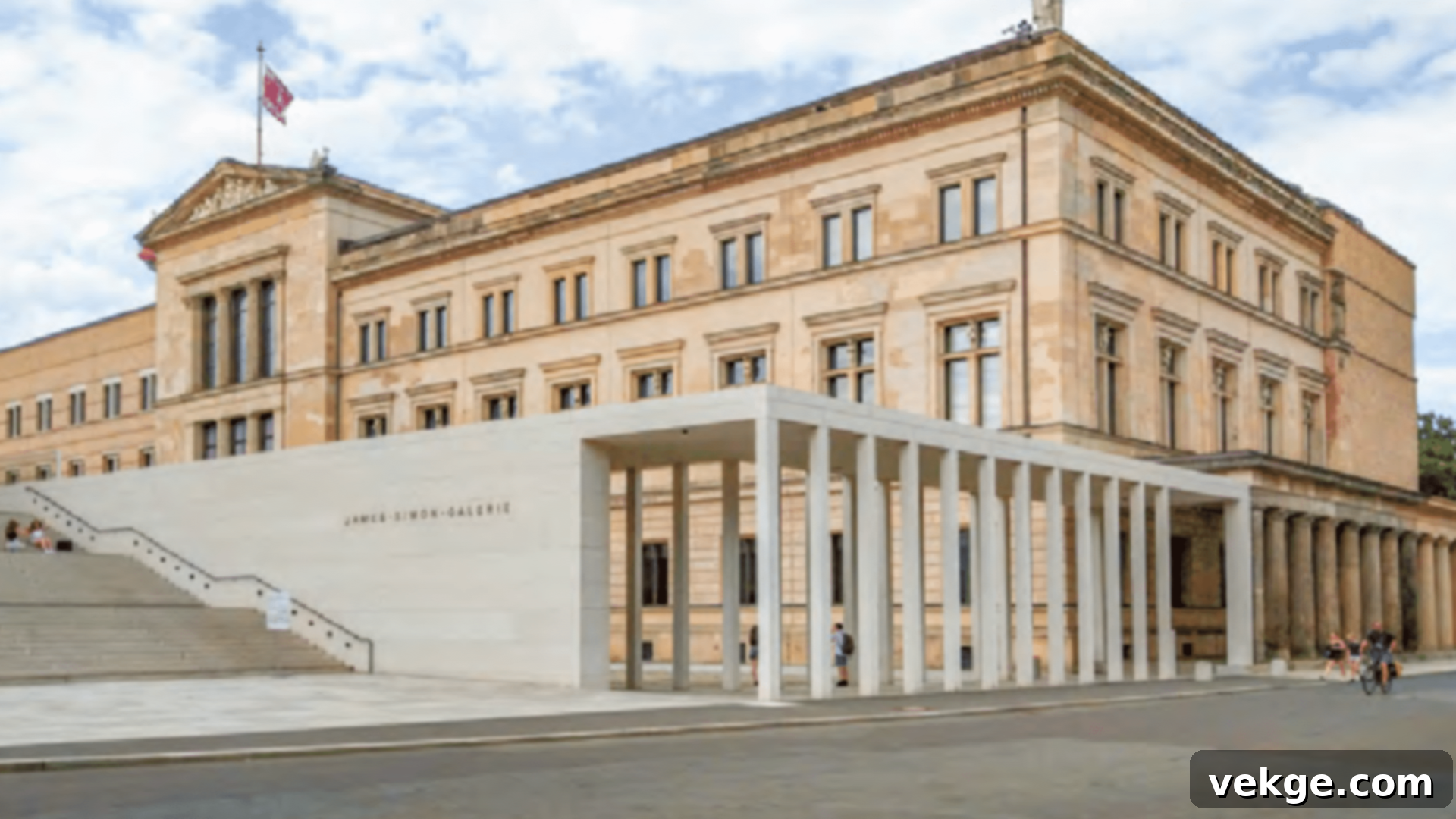
David Chipperfield completed the meticulous restoration of Berlin’s Neues Museum in 2009, an astonishing 70 years after it was severely damaged during World War II. Rather than attempting to recreate the original 1859 building identically, Chipperfield’s sensitive approach transparently reveals the structure’s complex history. He achieved this by carefully preserving visible war damage alongside thoughtful restoration and contemporary additions. This strategy creates a powerful dialogue between past and present.
New materials, such as brick, concrete, and bronze mesh, complement but remain distinctly separate from the original elements, allowing visitors to discern the layers of history. The museum now proudly houses the Egyptian and prehistoric collections, including the world-famous bust of Nefertiti. This sensitive renovation project exemplifies how innovative architectural intervention can add profound meaning to historic structures without erasing their scars, honoring their journey through time.
15. Vitra Campus (Germany)
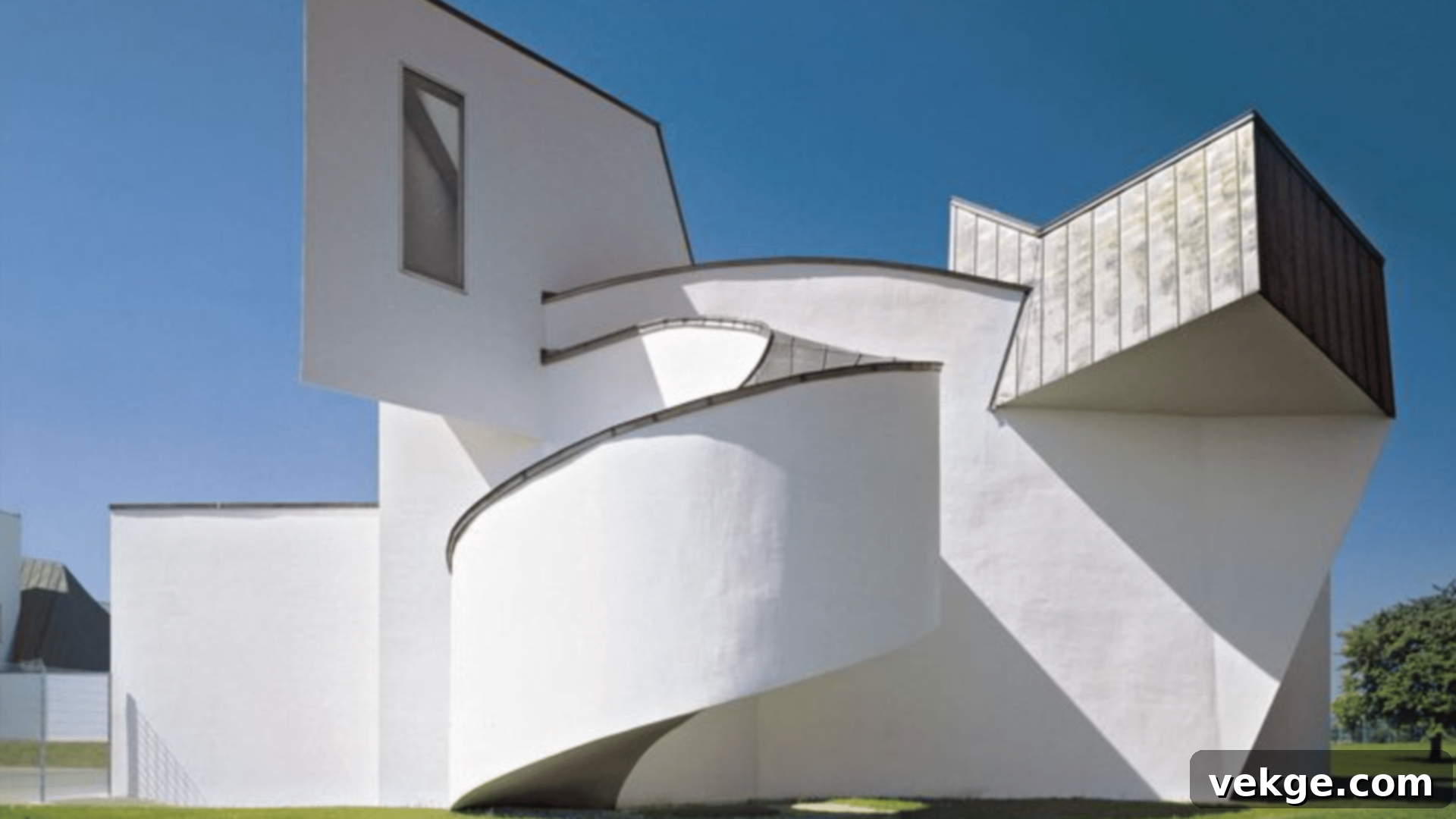
The Vitra Campus in Weil am Rhein, Germany, has evolved since 1989 into an extraordinary collection of buildings designed by some of the most celebrated architects of our time. Following a devastating fire that destroyed factory buildings, furniture manufacturer Vitra embarked on a visionary project, commissioning Zaha Hadid for her first completed project: a striking, dynamic fire station. This initial commission set the precedent for an architectural park unlike any other.
Frank Gehry contributed a distinctive design museum with iconic curved white forms, while Herzog & de Meuron created a minimalist storage building composed of stacked concrete panels. Master architects like Tadao Ando, SANAA, and others have since added their unique structures, showcasing diverse approaches to contemporary architecture. The campus functions simultaneously as a working factory and an architectural park, offering visitors a rare opportunity to experience buildings by different masters in close proximity. This unparalleled concentration of significant works represents an ongoing experiment in architectural diversity within a cohesive manufacturing facility, making it a pilgrimage site for design enthusiasts.
Exploring Key Modern Architecture Styles
Modern architecture is not a singular monolithic style but rather an umbrella term encompassing several distinct movements that developed throughout the 20th century. These varied approaches reflect how architects responded to new technologies, evolving social needs, and changing artistic philosophies, each leaving an indelible mark on the built environment.
International Style
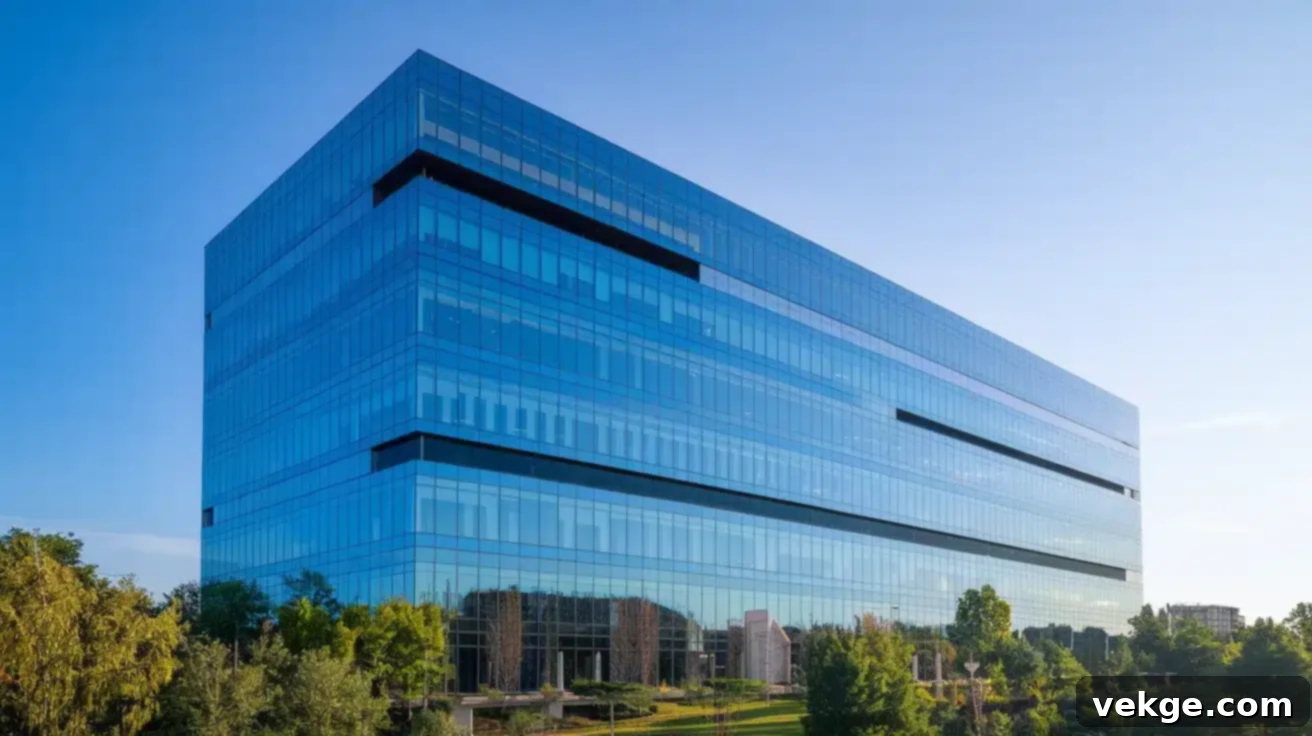
The International Style, emerging prominently in the 1920s, dominated architectural discourse and practice through the mid-century. This style championed the creation of universal buildings, free from local traditions and historical ornamentation, capable of functioning anywhere in the world. Its core tenets were derived from a commitment to functionality, a celebration of new industrial materials, and a rational, unadorned aesthetic.
Structures in the International Style are characterized by flat roofs, often used as functional spaces; unornamented facades, typically smooth and white; and an emphasis on rectangular forms. They feature regular patterns of windows, often arranged in horizontal bands, and open interior spaces with minimal partitioning. Materials such as steel, concrete, and large expanses of glass are deliberately left visible, expressing their intrinsic qualities rather than being concealed. The style disseminated globally through influential works by pioneers like Ludwig Mies van der Rohe’s Seagram Building in New York and Le Corbusier’s groundbreaking Villa Savoye near Paris. Its clean, machine-like aesthetic quickly became the standard for corporate office buildings, institutional structures, and even some residential designs across the globe, defining the modern cityscape for decades.
Brutalism
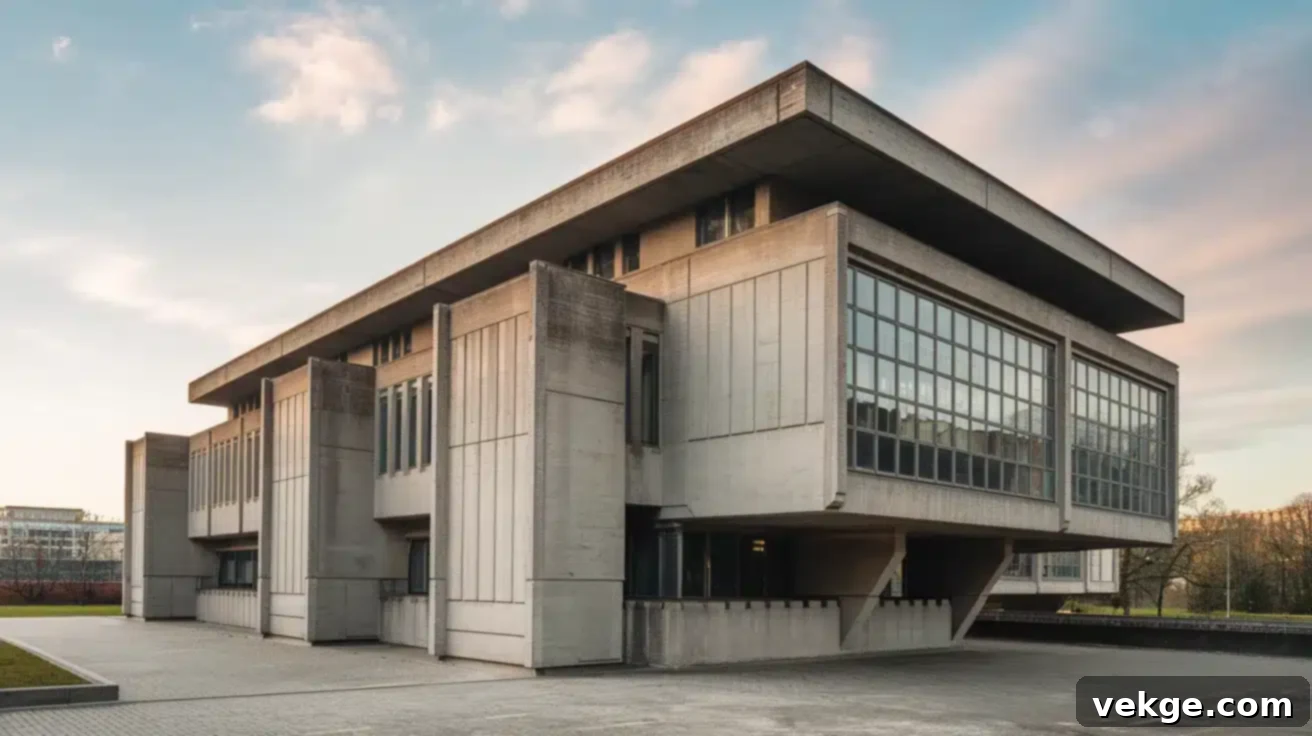
Brutalism gained significant popularity from the 1950s through the 1970s, establishing a dramatic and often controversial presence in modern architecture. Its defining characteristic is the uncompromising use of raw, exposed concrete, known as béton brut in French, which directly gave the style its evocative name. Brutalist architects sought to emphasize the raw honesty of materials and structure.
These buildings are instantly recognizable for their massive, block-like forms, often featuring exposed structural elements and textured concrete surfaces that conspicuously display the imprints of their wooden formwork. Brutalist structures frequently possess a fortress-like quality, with deep-set windows and dramatic shadows created by their imposing mass. Notable examples include Boston City Hall in the USA and London’s Barbican Centre, both celebrated for their bold, sculptural presence. While once frequently criticized for being cold, imposing, or unwelcoming, many Brutalist buildings are now undergoing a critical reassessment, with architects and critics recognizing their unique sculptural qualities, uncompromising honesty in material expression, and their often grand, civic ambitions.
Postmodernism
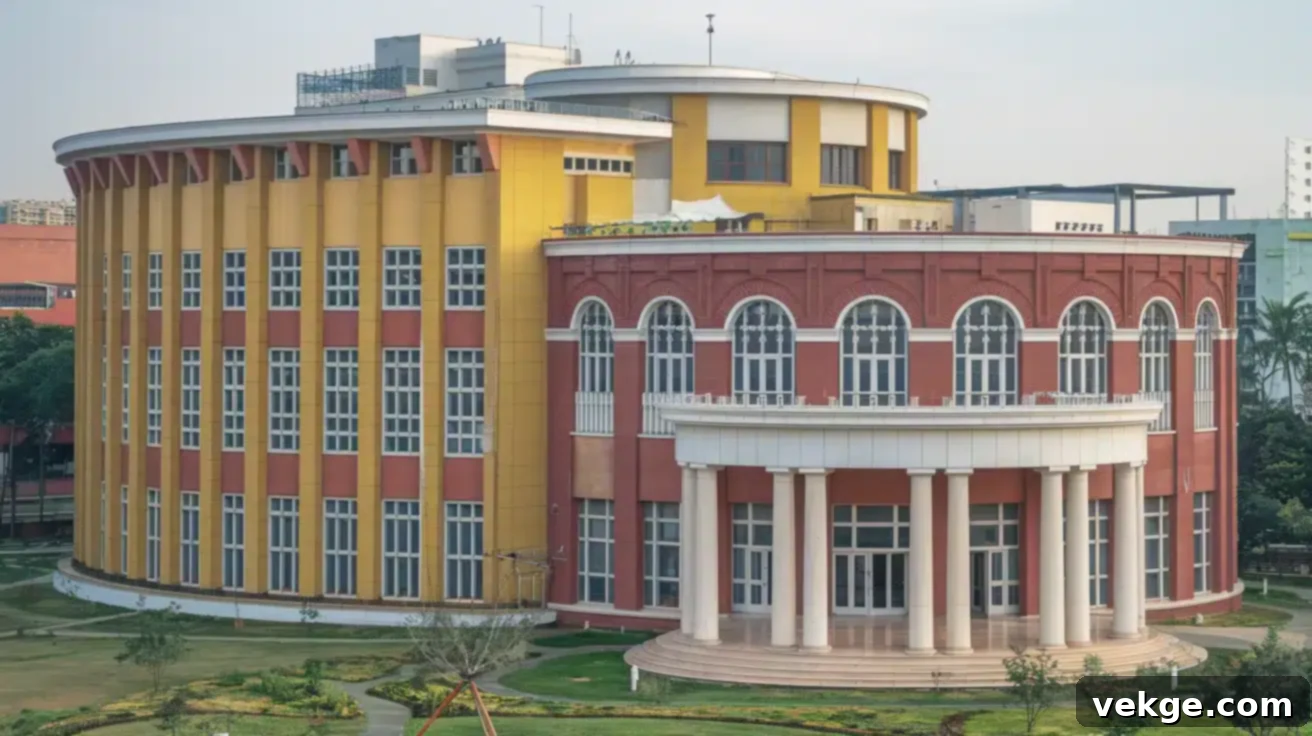
Postmodernism emerged in the 1970s as a direct and vibrant reaction against the perceived rigid rules, austere aesthetics, and plain, functional boxes of high modernism. This architectural style enthusiastically re-embraced color, rich decoration, symbolism, and a wealth of historical references that modernism had explicitly rejected. Postmodern buildings are characterized by their eclectic nature, often playfully mixing different historical styles with modern construction techniques, sometimes employing familiar forms in unexpected ways or at exaggerated scales.
They frequently incorporate playful elements, visual metaphors, and even architectural “jokes” that directly challenged the serious, functionalist ethos of modern architecture. This movement sought to bring back a sense of wit, irony, and humanism into design. Notable examples include Charles Moore’s vibrant Piazza d’Italia in New Orleans, celebrated for its theatrical and symbolic use of classical elements, and Philip Johnson’s iconic AT&T Building (now 550 Madison) in New York, with its distinctive broken pediment top that humorously resembles an antique piece of furniture. Postmodernism proved that buildings could be both functional and expressive, bringing a rich tapestry of meaning and aesthetic diversity back to the urban fabric.
Conclusion: The Enduring Legacy of Modern Architecture
Over the past century, modern architecture has irrevocably transformed our skylines, neighborhoods, and indeed, our very way of living. From the sleek, soaring office towers of downtown business districts to the bright, open-plan suburban homes, its foundational principles – a commitment to honest materials, expansive open spaces, and clean, unembellished lines – have become deeply embedded in our everyday surroundings. This global language of design, adaptable across diverse cultures and climates, has created a coherent yet varied aesthetic that continues to evolve.
The next time you find yourself strolling through a city or even within your own home, take a moment to consciously observe modern architecture’s profound influence. Those expansive windows that flood interiors with light, the seamless flow of open floor plans, and the elegant simplicity of forms are ubiquitous once you train your eye to recognize them. If you’re considering renovating your current space or embarking on a new design project, consider thoughtfully incorporating some of these timeless modern ideas. Simple changes, such as maximizing natural light, opening up cramped rooms, or simplifying decorative elements, can dramatically enhance your environment. These thoughtful interventions can make spaces feel significantly larger, brighter, and more intrinsically connected to the outside world, creating a contemporary and inviting atmosphere.
Frequently Asked Questions About Modern Architecture
How can I incorporate modern architecture elements into my home?
You can easily infuse modern architectural elements into your home with a few strategic changes. Consider maximizing natural light by enlarging windows or adding skylights. Adopt an open floor plan by removing non-load-bearing walls to create a more fluid living space. Opt for furniture and decor with clean lines and minimal ornamentation. Utilize a neutral color palette with pops of accent colors. Additionally, consider using materials like glass partitions instead of solid walls to enhance visual connectivity and light, or introduce exposed natural materials like concrete or wood for an authentic modern touch.
Can modern architecture be applied to small homes?
Absolutely, modern architecture principles are exceptionally well-suited for small homes. Its focus on efficiency, open spaces, and maximizing light can make smaller residences feel much larger and more functional. Strategies include smart space planning with multi-functional areas, incorporating built-in storage solutions to reduce clutter, using glass walls or sliding doors to create visual depth and connect spaces, selecting multi-functional furniture, and establishing strong indoor-outdoor connections through patios or large windows. These elements create a sense of expansiveness and contemporary living even within compact footprints.
Can modern architecture be used in both residential and commercial buildings?
Yes, modern architecture is incredibly versatile and adaptable for both residential and commercial applications. The fundamental principles—such as prioritizing functionality, using honest materials like steel, glass, and concrete, emphasizing natural light, and employing clean, uncluttered forms—translate effectively across different building types. While the scale, specific functional requirements, and privacy considerations will differ, the core tenets of modern design work brilliantly for houses, apartments, offices, retail spaces, and large public buildings alike, offering solutions that are efficient, aesthetically pleasing, and timeless.
